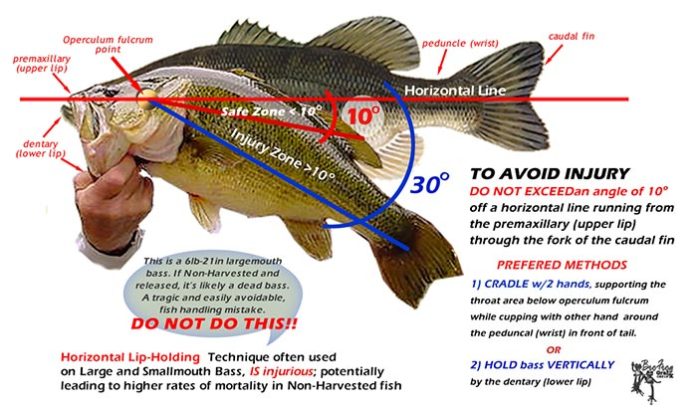Graphic by Les Booth
Fly fishers have spent a lot of time over the past few years trying to promote the #Keepemwet ethic as a way to ensure the highest survival rates from catch-and-release fishing. What we’ve talked about less is how the ways that we hold fish can also do damage.
For more than a decade, Indiana angler Les Booth has made it his mission to get anglers to stop employing the Horizontal-One-Hand-Lip-Grip-Hold when they show off their bass. You’ve seen this grip a hundred times on Facebook and on Saturday-morning fishing shows. What’s remarkable is that even the world’s most famous bass anglers do it, which then promotes the practice among members of the amateur-angling community. (Although some of the pros are trying to change.)

Rob Woodruff of Woodruff Guide Service shows how to properly support a bass’s body.
Photo by Jenny Mayrell-Woodruff
Why is this a problem? I’ll let Les explain:
It’s a muscle thing. Bass ( and all sunfish) eat by sucking prey into their buccal cavity (mouth). It’s a five-step process that works like this: 1. Open Jaw; 2. Suck in water and prey; 3.Close Jaw; 4. Expel water out gills; and 5. Swallow prey (food). It is that simple. However, the force generated to generate the necessary suction is considerable and requires a great deal of muscle strength. The muscles needed to do this are all jointly connected to the operculum fulcrum point (OFP). This is the same point where, in an improperly held fish, all the pressure of the fish’s body weight—suspended without support—is focused. When those muscles are strained or injured, let alone torn, the fish’s ability to generate the suction necessary to capture prey is greatly reduced or, eliminated.

Graphic by Les Booth
Booth goes on to offer solutions to this pervasive problem:
- Simply holding the fish with two hands, in a horizontal position will work best.
- A purely vertical hold by the lower lip is okay for smaller fish only. Large bass, those fish over 3 pounds, suffer an elevated potential for internal damage from the vertical position, which should be avoided.
The best solution to the problem is what Booth calls the Lite-Touch™ method:
- Minimal contact with the fish
- Horizontal, two-hand support
- Short duration of handling.
These are clearly good rules for handling any fish you plan to release.
Click here for Les Booth’s complete discussion of the problems with the Lip Grip. And feel free to share the graphics above, which can be found here and here.
Credit: Source link































